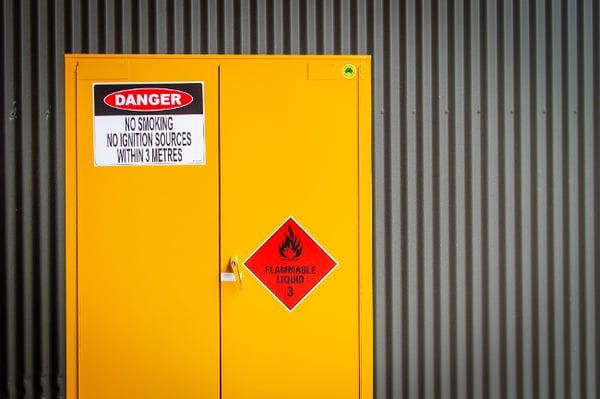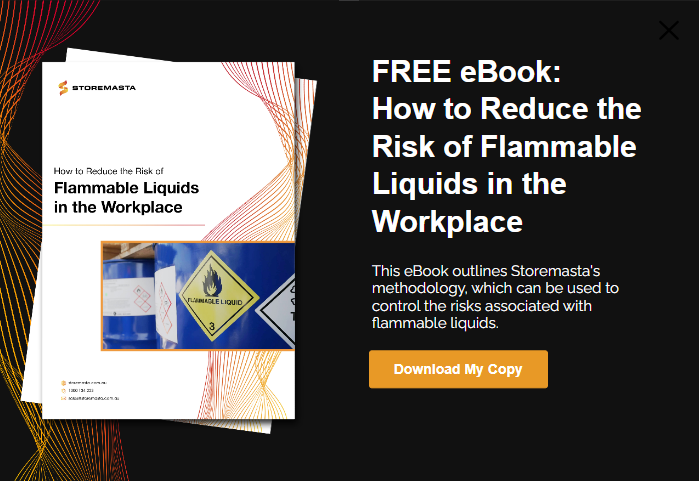If you work with flammable liquids storage cabinets, you understand that they’re in place to help your workplace reduce the risks and hazards associated with flammable liquids use and storage. As a Class 3 Dangerous Good, flammable liquids have the potential to cause serious damage to the people and property of your organisation, as well as the surrounding environment. As Dangerous Goods Specialists, we get asked a lot of questions about the safe storage of flammable liquids. And one of the questions that we hear often from customers is ‘do flammable cabinets need to be locked?’.
So, in this blog, we take a deeper dive into this specific type of safety cabinet. We’ll explain how a flammable cabinet works, the features of a compliant cabinet, and how a cabinet should be used to maintain workplace safety and compliance.
How Does a Flammable Cabinet Minimise Risk?
As we have touched on, safety cabinets are specifically designed to minimise the risks associated with dangerous goods storage. A flammable cabinet, therefore, is manufactured in accordance with Australian Standard AS 1940 – The storage and handling of flammable and combustible liquids.
Because of the unique physical and chemical properties of this type of hazardous substance, a flammable liquids cabinet must be constructed to specifically address the particular risks and hazards associated with the use and storage of Class 3 Flammable Liquids.
A flammable cabinet is designed to provide a range of protective measures including:
- Product protection – the cabinet is manufactured to provide protection for the contents within the cabinet, so flammable liquid containers don’t sustain damage
- Spill containment – the cabinet is designed with a spill bund which will contain any possible chemical spills that occur within the cabinet
- Segregation – the cabinet provides dedicated flammable liquid storage, thereby reducing a potential workplace hazard with incompatabilities if the guidelines for segregation distances are followed
![]()
A compliant flammable cabinet provides a range of protective measures for your workplace.
Features of a Compliant Flammable Liquids Cabinet
To achieve risk reduction, a flammable liquids cabinet must be designed and constructed with a range of special features.
Compliant flammable cabinets must be constructed with:
- Heavy duty sheet metal – to protect the flammable liquids inside the cabinet from damage, the cabinet must be made with heavy duty sheet metal
- Self-closing, close-fitting doors - to ensure that all the contents within the cabinet are always shielded from other incompatible substances, compliant flammable cabinets must be fitted with self-closing, close-fitting doors
- Spill containment – as a bunded storage solution, flammable cabinets need to be constructed with a spill containment sump. This allows the sump to catch any spills that may occur within the cabinet
- Dual skinned construction - to provide insulation and prevent flammable liquids within the cabinet from immediately igniting in the event of a fire
Lockable Doors
Because most flammable liquids storage cabinets also have lockable doors, some WHS staff think that it’s a regulatory requirement to keep flammable cabinets locked.
However, this common practice of locking flammable cabinet doors is not actually a legal requirement.
The Australian Standard AS 1940:2017 states that:
4.9 STORAGE IN STORAGE CABINETS
4.9.2 Cabinet construction
(f) All cabinet doors shall be self-closing, close-fitting and held shut automatically by catches at two or more points.
However, while the standard stipulates that the doors need to be self-closing, close-fitting and held shut automatically, there is no reference that requires flammable cabinets to always be locked.
Therefore, when referring to the standard, you can feel confident that flammable liquids storage cabinets can be kept unlocked, if required.

You may lock the cabinet if required but it's not a requirement.
Is it Good Practice to Lock Flammable Cabinets?
So if it isn’t a mandatory requirement to lock flammable liquids storage cabinets, is it still a good idea to lock the cabinets when they’re not in use?
The answer comes down to the specific requirements that your workplace has for flammable liquids storage.
For example, if the contents of your cabinet are highly flammable — and only certain people in the workplace are authorised to use it — locking the cabinet could be an effective risk control measure. By locking the cabinet, you’re ensuring that only authorised personnel have access to the highly flammable liquids.
On the other hand, if your flammable liquids are regularly required by a range of staff members, it may be reasonable to allow the cabinet to remain unlocked so they can gain easy access to the flammable liquid supplies.
However, it’s important to remember that all staff must be trained in the correct way to handle and store flammable liquids, so your workplace can minimise any potential hazards. Flammable liquids, as we’ve discussed, can cause severe damage to people and property. They have the potential to cause serious hazards such as fires and explosions if they meet an ignition source or an incompatible substance.
Therefore, you should continue to monitor the use and maintenance of your cabinet to reduce any risks. If you are concerned about staff accessing the cabinet when it is unlocked, you should implement risk control measures to maintain the safe handling and storage of flammable liquids at your workplace.
Pros & Cons Of Locking Flammable Liquid Storage Cabinets
So, what are the pros and cons of locking your flammable cabinet? We outline a few of the key points so you can make a more informed decision for your workplace.
Pros
The benefits of locking your cabinet may include:
- Authorised use – locked cabinets allow only authorised personnel to have access to highly flammable liquids
- Reduced risk of theft – locking your flammable cabinet can reduce the risk of inventory theft by controlling access to the stock
- Reduced risk of inventory wastage – by controlling who can and can’t access the cabinet, you can more chance of reducing inventory wastage
Cons
Some issues that may be created by choosing to lock your flammable cabinet may include:
- Lack of access – there is a risk of not being able to obtain packages of flammable liquids when required. A locked cabinet may result in downtime in production processes
- Fire or emergency – a locked cabinet poses a risk of not being able to access the cabinet in the event of a fire or emergency
- Spill response – locking a flammable cabinet may cause a delay in spill response. If there has been a major spill within the cabinet, the cleanup may be delayed due to lack of access
Safe Storage of Flammable Liquids
While we’ve explained that the Australian Standard AS 1940:2017 doesn’t make the locking of flammable liquids storage cabinets a mandatory requirement, we have shown that locking a cabinet can be an important risk control measure.
The benefits of locking a flammable liquids storage cabinet can include the prevention of unathorised access, and the reduction of risk for inventory wastage and theft. Regardless of what type of flammable liquids that you are storing, it’s a good idea to consider how this risk control measure could affect your workplace.
If you’d like to learn more about reducing the risks of flammable liquids, why not download our FREE eBook. Our handy guide How To Reduce The Risk Of Flammable Liquids In The Workplace details our expert tips on risk reduction. It also outlines our 4-Step Risk Management Methodology of IDENTIFY – ASSESS – CONTROL – SUSTAIN that you can easily implement in your own workplace. Click on the image below and find out more about it today.
Joining the team as a Dangerous Goods Storage Consultant, Melissa Hampton became Storemasta's Marketing Manager in late 2021. With extensive knowledge and experience in chemical compliance, Melissa is responsible for leading the Marketing team and helping shape their marketing strategy. In her spare time, you can find Melissa hiking, swimming and enjoying the great outdoors in beautiful north-west Tasmania.
